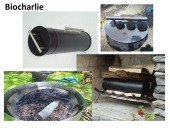




Life on a farm is a school of patience; you can't hurry the crops or make an ox in two days.
Henri Alain
 3
3




Silence is Golden
For all your RMH needs:
dragontechrmh.com
 2
2




Gerry Parent wrote:Hi Mart,
I have done this with my Batch Box several times now this winter using the same technique in the video and it worked out quite well.
Since my biochar needs are minimal however, I have decided to stop this process and instead just wait until ash cleanout time and filter out the charcoal with a screen.
My batch naturally leaves enough charcoal behind to suit my needs which saves me from having to fill and empty the retort all the time.
Good luck with your experiments.
Life on a farm is a school of patience; you can't hurry the crops or make an ox in two days.
Henri Alain




Carbon Negative Stove plans available at:
https://www.carbonconsciouscreations.com




Martijn Macaopino wrote:Which scale are you working with and how big are your heating needs?
In my personal experience the best way to make high quality biochar indoors is with TLUD stoves that use syove pellets as the fuel. If you have a good sawdust supply you could consider your own pelletizer to make stove pellets.
A good alternative would be an outdoor retort system where the smoke is condensed, the heat that is extracted during this condensing of the smoke used to feed into a hot water system for the house and then the remaining non condensable gasses are fed into your generator. Then you end up with hot water, biochar and electricity.
If you are not in need of biochar then a traditional wood gasifier such as for example a FEMA gasifier or the designs from the likes of Mr Teslonian or Randominium on youtube will suit your needs when it comes to energy production.
P.s. it's not really biochar if you intend to burn the material down to ashes again ;)
Life on a farm is a school of patience; you can't hurry the crops or make an ox in two days.
Henri Alain
 1
1




 2
2








 1
1




 2
2




![Filename: Black-gunk-opt.jpg
Description: [Thumbnail for Black-gunk-opt.jpg]](/t/155659/a/161491/Black-gunk-opt.jpg)
![Filename: Day-2-results-2-opt.jpg
Description: [Thumbnail for Day-2-results-2-opt.jpg]](/t/155659/a/161492/Day-2-results-2-opt.jpg)
![Filename: 2x2-opt.jpg
Description: [Thumbnail for 2x2-opt.jpg]](/t/155659/a/161493/2x2-opt.jpg)
 2
2








Mike Farmer wrote:Interesting design, Joshua. One question - does your system burn off off-gasses from the charred wood? Or are they just escaping through the holes in the top of the lid?
“So I'm lightin' out for the territory, ahead of the scared and the weak and the mean spirited, because Aunt Sally is fixin’ to adopt me and civilize me, and I can't stand it. I've been there before.”
 2
2




Joshua States wrote:No, I do not have this kettle set up as a retort. As I mentioned in the posts above, a true retort has a way to channel the off-gasses back into the burn chamber. They just escape through the holes in the lid. They don't actualy escape into the air. During the burn I have noticed small flames in short bursts out of the holes. These are the hot gasses combining with oxygen and igniting.

|
This tiny ad helped me apply for a passport. Denied.
Rocket Mass Heater Jamboree And Updates
https://permies.com/t/170234/Rocket-Mass-Heater-Jamboree-Updates
|




